Featured Topics
Featured series.
A series of random questions answered by Harvard experts.

Explore the Gazette
Read the latest.
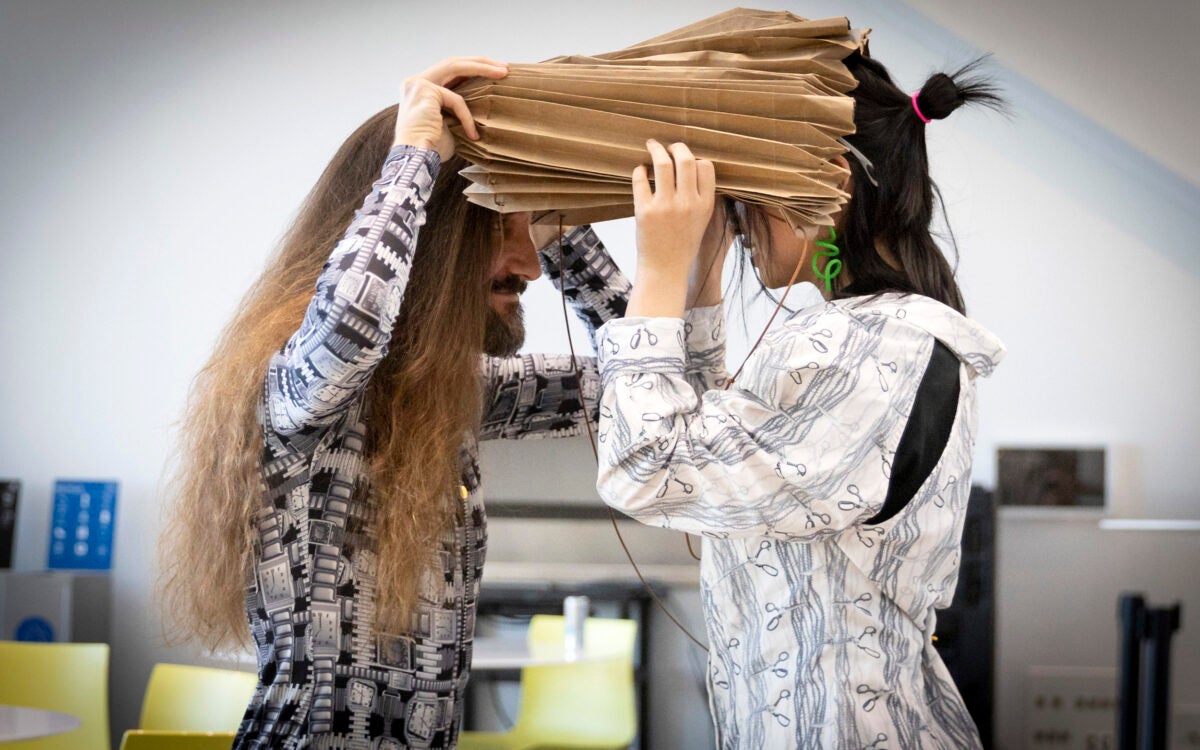
Everything, everywhere, all at once (kind of)

Acclaimed poet receives Arts Medal

DuVernay on exploring racism, antisemitism, caste in ‘Origin’
Armchair travels with a purpose.
Students wearing 3D glasses take a virtual tour of ancient Egypt in Peter Der Manuelian’s “Pyramid Schemes” class.
Photos by Stephanie Mitchell/Harvard Staff Photographer
Alvin Powell
Harvard Staff Writer
Digital Giza Project lets scholars virtually visit sites in Egypt and beyond, and even print them in 3D
Four thousand years ago, a member of Egypt’s elite was buried on the Giza Plateau in an elaborate stone tomb, complete with several rooms and underground chambers.
Then, in 1912, a team from Harvard University and the Museum of Fine Arts (MFA) in Boston excavated the tomb, of a type called a mastaba , and brought back with them a limestone wall from its chapel.
The wall, housed at the MFA, is inscribed with images of the deceased, an official named Akh-meret-nesut, and his family in various poses — sitting, leaning on a staff, throwing a lasso.
Today, more than a century later, Harvard doctoral student Inês Torres wants to know as much as she can about Akh-meret-nesut: who he was, what he did, and why he was buried on the Giza Plateau in the shadow of the pyramids long after pharaohs’ burials there had ceased.
But Torres faces a problem familiar to many scholars studying ancient Egypt: getting access to what she’s studying. With part of the tomb in Boston and part in Egypt, she’d have to time travel to see it intact. Other scholars may face different hurdles, but the problem is the same: Documents and images are held in faraway archives, artifacts and other relics of ancient Egypt have been dispersed, stolen, or destroyed, and tombs and monuments have been dismantled, weather-worn, or locked away behind passages filled in when an excavation closes.
Hurdles can also be economic: The object of study may be intact, but the plane fare and expenses of living for weeks in the field or lodged in the cities — Cairo, London, Berlin, Paris, Boston — that are home to museums with large Egyptian collections hard to come by.
It was with scholars like these in mind that Digital Giza Project was born.
The project was created in 2000 by Peter Der Manuelian , who at the time was on the curatorial staff at the MFA. A scholar of ancient Egypt, Manuelian said his initial vision was to create a digital record of the work of Harvard’s legendary Egyptology Professor and MFA curator George Reisner and the Harvard-MFA Expedition he led. The expedition was one of the major academic archaeological efforts at Giza and other sites in Egypt during the early 1900s.
Reisner, who led the expedition for more than 40 years, dug at 23 sites, and Manuelian soon realized that just digitizing material relating to the vast finds on the Giza Plateau — which includes not only the pyramids and the Sphinx, but also associated temples, nearby cemeteries, and even a workers’ village — would be a career-long challenge. In 2010, he moved to Harvard to become the Philip J. King Professor of Egyptology and director of the Harvard Semitic Museum , and he brought the Giza Project with him.
The project staff’s ambition has since expanded to include not just Reisner’s work at Giza, but that of other archaeologists at the site as well, making it a comprehensive resource for Giza archaeology. It contains some 77,000 images, 21,000 of them Harvard University-MFA Expedition glass-plate negatives, and 10,000 of Manuelian’s own images. It has published manuscripts as well as unpublished expedition records, dig diaries, object record books, and sketches and drawings made by the archaeologists doing the digging. In January, during Harvard’s winter recess, Manuelian visited Egypt and collected another 5,000 digital images — including panoramic photos — of Giza and related objects in the Egyptian Museum in Cairo.
A key feature of the Giza Project is the fact that the material it holds is cross-referenced online, allowing a researcher to seamlessly move from a 3D image of an object to scholarly articles about it to diary pages by the archaeologist who discovered it.
“For people who focus on this particular period, this is the main resource for them to go to,” Manuelian said. “It’s thrown the doors wide open to this material that was previously only in the publications that Reisner lived long enough to finish.”
As the work has advanced, so has technology. Manuelian’s vision has expanded to include 3D re-creations of statues and artifacts that allow researchers to view them online, rotate them, and zoom in on specific features. Looking to the future, he said, 3D models’ source codes could be made available, which would allow distant scholars with access to 3D printers to create their own physical models.
“All of this allows us to ask new questions and to put the data together in ways not possible before and to make intelligent links,” Manuelian said. “If someone gets a grant and decides to go to the MFA and look through their records, good luck. There’s just so much, it’s overwhelming. If you go to Giza today, a tomb may have been reburied or vandalized, or is in not as good shape as it was in 1916. Objects might have gone to the basement of the Cairo museum, never to be seen again.
“With our attempt to put this all together digitally, with diaries and maps and plans and things, it allows you, first of all, convenient access to the data and then you can start to notice patterns.”
The Giza Projects’ 3D modeling extends beyond artifacts to locations. Manuelian’s team has already created video-game-like 3D versions of the entire Giza Plateau, with the Khafre pyramid, the Sphinx, and several temples and tombs posted so far and more to come. Those models can be accessed from the Digital Giza website and toured using controls on a laptop or desktop computer. Other re-creations, using high-resolution photographs of tombs’ interiors, let visitors walk through virtual burial chambers using stereo headsets. Visitors can move around inside the tombs and even walk up to a wall to examine a particular relief or other detail. About 20 tombs have been modeled in detail so far, with hundreds more to go.
“My hope is eventually to fly drones over the site, documenting everything from the air,” Manuelian said. “And complementing that with walks up and down the ‘streets’ [between rows of tombs] creating 360-degree panoramic visualizations, all linked to the more-traditional archaeological data that we have already assembled.”
For someone like Torres, studying a tomb that has one room in Boston and the rest in Egypt, a virtual model is the only way to see the intact structure, so she’s planning on creating one as part of her doctoral work.
“This tomb is divided between two countries,” she said. “3D modeling is the only way we can put it back together again.”
The overarching goal, Manuelian said, is to make scholarship in Egyptology more accessible than ever. And, while digital images may not fully replace the real thing, he said, foundational study can be conducted using the wide array of material presented by the project, allowing scholars to conserve scarce resources for when they’re essential.
The project’s 3D re-creations and data visualizations, together with the capabilities of the Harvard Visualization Center, also allow the Giza Project to give students a unique educational experience. Last fall, Manuelian gathered his students in a tomb in cyber space, using the center’s virtual reality headsets, and linked the class to students in Zhejiang University in China. Students’ avatars gathered at the virtual site — in this case, the Sphinx — with the technology, allowing Manuelian to act as a cyber tour guide.
“The project is all of these diverse approaches,” Manuelian said. “It’s a traditional database and website. It’s the intelligent linking of this photo to that tomb to this diary page. It’s the 3D modeling as we try to build more and more of the necropolis all the time. And it’s ultimately intended to enable the kind of remote teaching — what I call educational telepresence — where we can all be at Giza virtually and visiting the site and having a lecture inside a decorated tomb chapel no matter where you live.”
Torres said there is an irony to studying Giza: It is one of the world’s most famous archaeological sites, but in many ways it is still unknown. While the pyramids and Sphinx are world-famous, and have been for centuries, in their shadow new tombs are still being uncovered, while known tombs, workers’ houses, and other sites are yet to be fully explored and studied.
“Giza is such a well-known site, but in some sense, it’s understudied,” Torres said. “Because the pyramids are so amazing, the things all around them fade.”
With so much work to be done, the access to digitized documents and materials might inspire scholars curious about ancient Egypt but without access to the sites themselves or a major Egyptological library to take up the job.
“I think that’s the way to go forward, to make sure everyone has access,” Torres said. “Possibly there are geniuses who don’t have a great library and could do something wonderful with the information.”
Another graduate student, Hilo Sugita, plans to study the sarcophagi found at Giza. Using the Giza Project’s data, she can examine photographs of inscriptions, find their original locations within tombs, and even create 3D models.
More like this
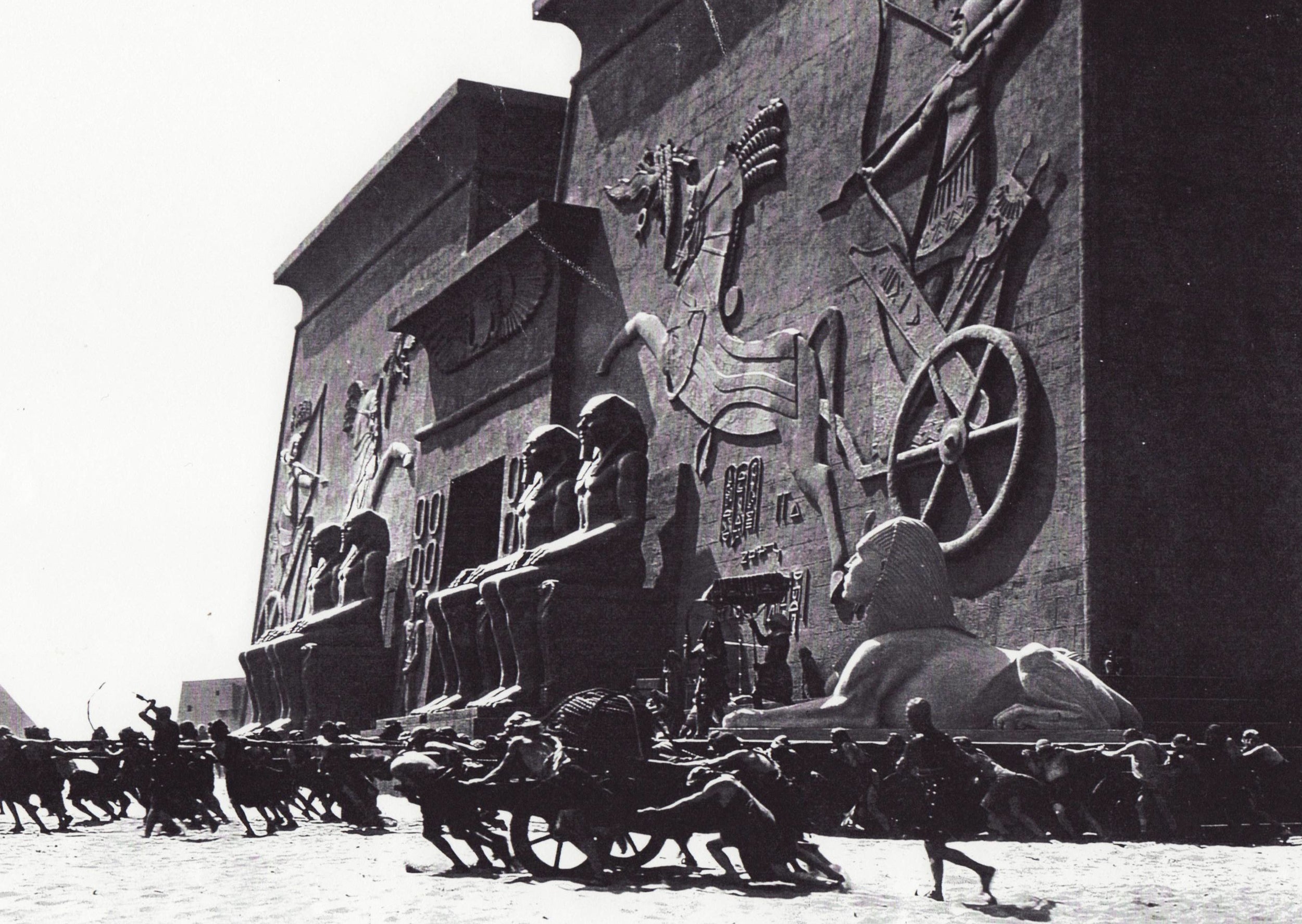
The search for a California sphinx
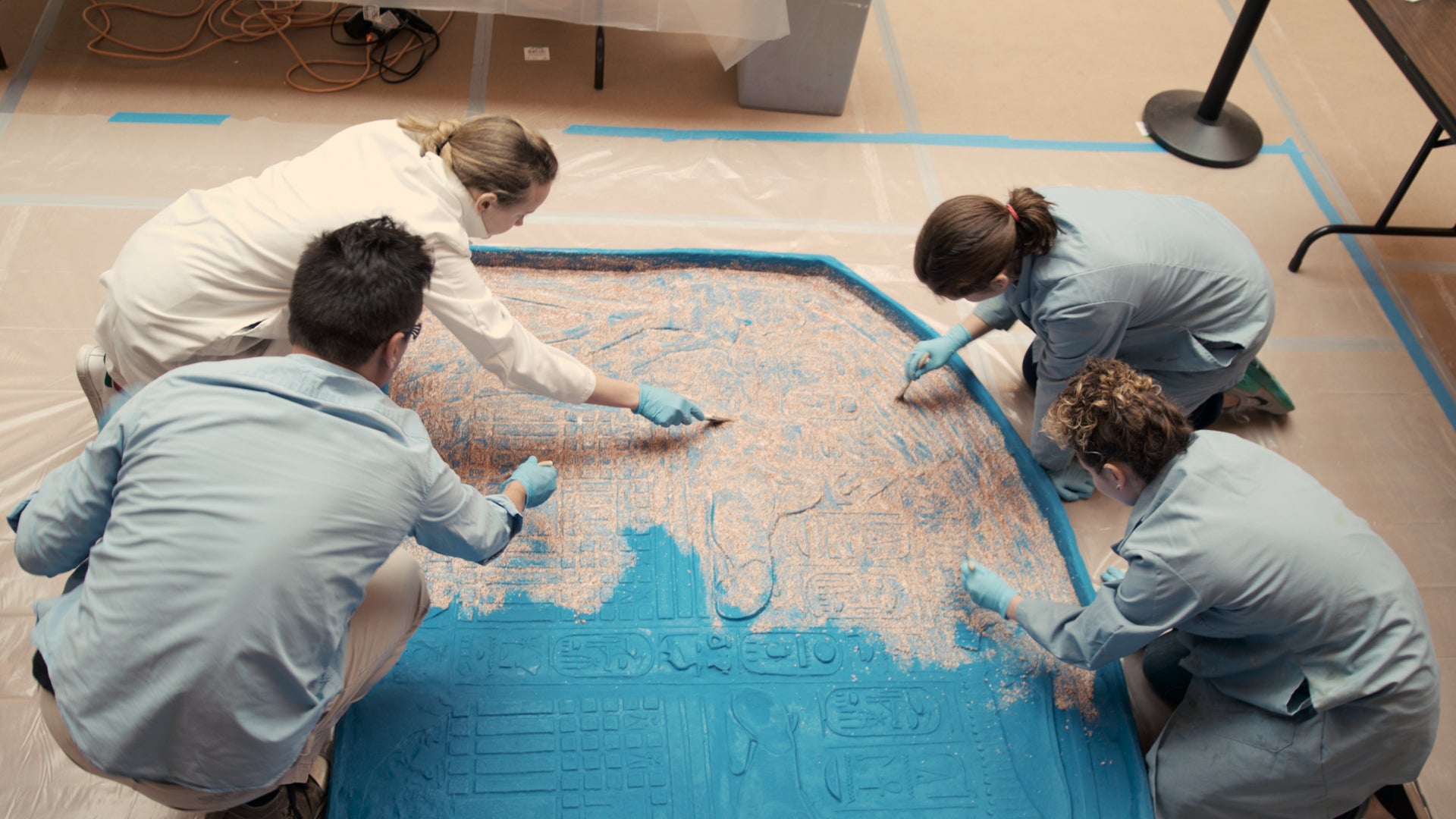
A cast fit for an Egyptian king
“We have photographs, journals, glass negatives, letters, artifacts, publications,” Sugita said. “I think the Digital Giza Project is amazing because we’re trying to collect all the data about Giza everywhere and make it available on the website. You don’t have to go to the MFA, you don’t have to travel to Berlin.”
Technology’s advance is not without challenges, however. The digitization of archaeology, Manuelian said, is something like “the Wild West,” with competing file formats and uncertainty about how the growing data troves will be translated into next-generation software.
In addition, standards for what goes into a 3D re-creation are loose. Should a digital model reflect the state of a tomb as it was found, for example, or is it OK to color in reliefs on the walls to match paint residue found there? How far should digital re-creations go in filling in missing details, some of which are backed by scholarship, but others of which are more speculative, driven by knowledge of common practice rather than evidence at that specific site?
Early in the spring term, Manuelian gave students in his Gen Ed “Pyramid Schemes” class, which provides an overview of ancient Egypt, a glimpse of Giza using Giza Project models. The students visited the Harvard Visualization Center’s home on the second floor of the Geological Museum building, which is equipped with a curved floor-to-ceiling screen occupying one full wall and a suite of 3D and virtual reality tools.
He gave them a tour of both the technology — which can depict sites in detail — and the archaeology, showing them three-dimensional re-creations viewed with 3D glasses and letting them walk through a tomb via a virtual-reality headset.
Manuelian also encouraged students to not only soak up the experience, but to think about the challenges inherent in such an approach, where it might further education and scholarship, and what its shortcomings might be. And, with so much work still to do, he also made a pitch.
“This is a project that is waiting for people like you,” he said.
Share this article
You might like.
There’s never a shortage of creativity on campus. But during Arts First, it all comes out to play.
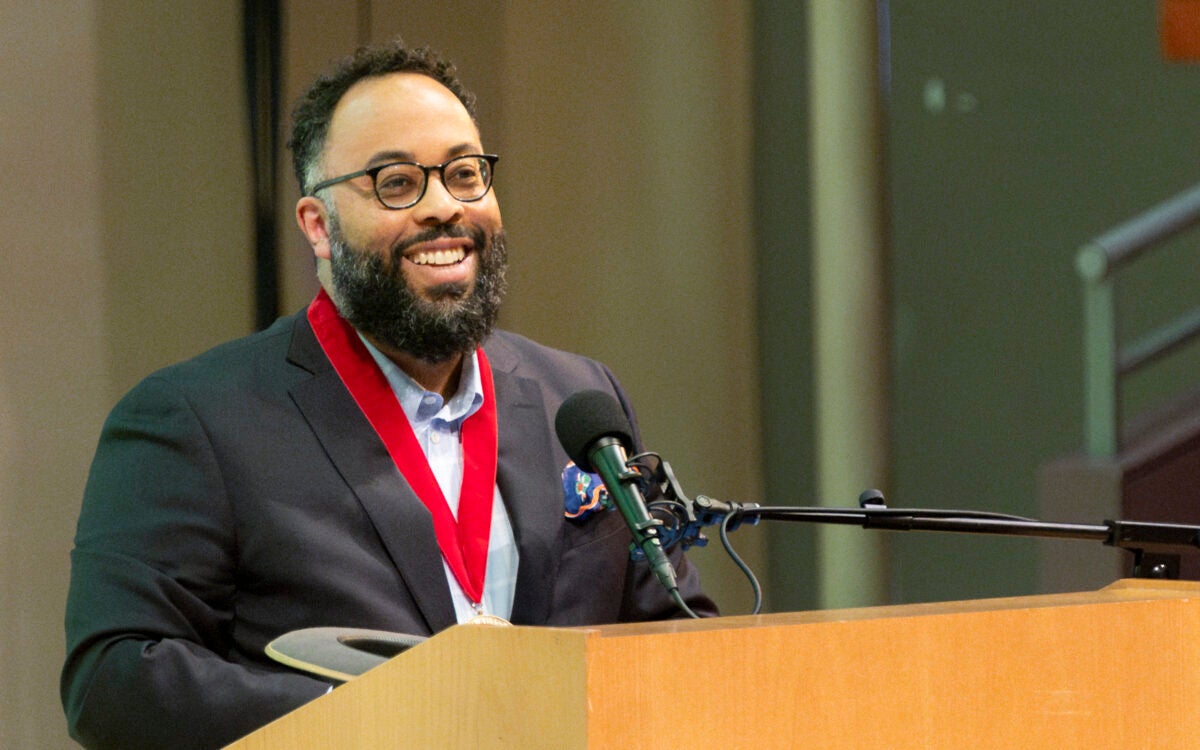
Kevin Young ’92 reflects on what took root at Harvard and how it’s grown

Despite horrors, film ‘a collection of love stories’
How old is too old to run?
No such thing, specialist says — but when your body is trying to tell you something, listen
Alcohol is dangerous. So is ‘alcoholic.’
Researcher explains the human toll of language that makes addiction feel worse
Seem like Lyme disease risk is getting worse? It is.
The risk of Lyme disease has increased due to climate change and warmer temperature. A rheumatologist offers advice on how to best avoid ticks while going outdoors.
Virtual Travel
A Smithsonian magazine special report
Take a Free Virtual Tour of Five Egyptian Heritage Sites
The sites include the 5,000-year-old tomb of Meresankh III, the Red Monastery and the Mosque-Madrassa of Sultan Barquq
Theresa Machemer
Correspondent
:focal(719x274:720x275)/https://tf-cmsv2-smithsonianmag-media.s3.amazonaws.com/filer/95/b4/95b48e97-391f-4f2c-9519-9fa5f170a51d/screen_shot_2020-04-17_at_14914_pm.png)
Earlier this month, Egypt’s Ministry of Tourism and Antiquities announced the release of five new virtual tours of historic sites, adding to the range of online adventures that you can now embark on from home.
The tours explore the tomb of Meresankh III , the tomb of Menna , the Ben Ezra Synagogue , the Red Monastery and the Mosque-Madrassa of Sultan Barquq . Each virtual experience features detailed 3-D imagery through which users can “walk” by clicking hotspots along the structures’ floors.
As James Stewart reports for the Guardian , the tours boast “beefed up” 3-D modeling made by experts with Harvard University’s Giza Project . Unlike their real counterparts, most of which charge a small entry fee, the virtual renderings are free to all.
“The virtual tours target both [international] tourists and Egyptians, a ministry spokesperson tells Al-Monitor ’s Amira Sayed Ahmed. “They serve the double purpose of promoting Egyptian tourism nationwide and increasing Egyptians' awareness of their own civilization.”
Two of the tours—the tombs of Meresankh III and elite Egyptian official Menna —include background information accessible by clicking circles overlaid atop specific features. The former’s tomb, dated to some 5,000 years ago, is the oldest of the Egyptian sites available as a virtual walkthrough. Meresankh, a queen wed to King Khafre, was the daughter of Prince Kawab and Hetepheres II of the fourth dynasty, and the granddaughter of Great Pyramid builder Cheops, also known as Khufu.
Harvard archaeologist George Andrew Reisner discovered the queen’s tomb in 1927. He later stated that “None of us had ever seen anything like it.” Today, the burial place’s paintings and carvings remain well-preserved, showcasing hunters catching water birds, bakers making triangular loaves of bread and servants holding offerings.
In the northern chamber, along the wall furthest from the virtual tour’s starting point, ten statues of women stand shoulder to shoulder—an unusual sight among Gaza tombs. The statues “serve to emphasize Meresankh’s position among her queenly relatives,” the tour explains. Along the path to the 16-foot-deep burial shaft, users pass a pair of statues depicting Meresankh and her mother, Hetepheres II, with their arms around each other.
The path leads down a spiraling staircase into the burial shaft, where Meresankh’s black granite sarcophagus—originally created for her mother but re-engraved upon the queen’s death in 2532 B.C., according to the History Blog —was originally found. The tour includes a reconstructed image of the chamber with the sarcophagus in place, but the actual coffin is now kept at the Egyptian Antiquities Museum in Cairo.
The tomb of Menna, dated to the 18th dynasty (about 1549 B.C to 1292 B.C.), is “one of the most visited and best preserved” from the era, the ministry writes in a statement quoted by Live Science ’s Laura Geggel. The tomb’s decorations suggest the elite official was a scribe in charge of the pharaoh’s fields and the temple of sun god Amun-Re.
Menna’s tomb also includes informational blurbs highlighting such features as paintings of the scribe’s family, including his wife Henuttawy and their five children. Curiously, all of the paintings of Menna have been defaced.
“The ancient Egyptians believed that the soul of a person inhabited paintings of them and destroying the face would ‘deactivate’ the image,” the tour notes. “Why would someone want to destroy the memory of Menna?”
The tomb also served as a point of communication with the dead. It once featured life-size statues of Menna and Henuttawy that family members could make offerings to, ask for favors or visit during festivals.
The other three tours do not offer information blurbs at this time, but they still have plenty of detailed 3-D imagery for virtual visitors to explore. The Red Monastery , a Coptic church in Upper Egypt, features ornate frescoes, while the 14th-century Mosque-Madrassa is known for its immense size and innovative architecture. The Ben Ezra Synagogue in Old Cairo is alleged to be the site where baby Moses was found.
“Experience Egypt from home,” says the Ministry of Tourism and Antiquities on Facebook . “Stay home. Stay safe.”
Get the latest stories in your inbox every weekday.
Theresa Machemer | READ MORE
Theresa Machemer is a freelance writer based in Washington DC. Her work has also appeared in National Geographic and SciShow. Website: tkmach.com
Nicole Legnani
- # david hopkins
- # giza project
- # jeremy kisala
- # museum of fine arts
- # peter der manuelian
- # rachel aronin
- # virtual reality
Bringing the Giza Pyramids to Life
3D or not 3D? That is the question. Egyptologists and digital artists discuss the advantages of navigating on screen through archaeological sites in 2D, versus donning 3D glasses for an even more immersive experience. Using 3D computer animation and digital artistry to reconstruct the ancient Egyptian site of Giza, arguably the most famous archaeological site in the world, the Giza Project at Harvard is bringing the site back to life on screen. This is happening at Harvard’s Visualization Center, located in the Geological Museum. Project staff, along with partners at Dassault Systèmes in Paris, are making it possible for students and researchers alike to become “participant observers” in the burial rites carried out by avatars of ancient Egyptians, and to experience the ancient landscape and monuments in real-time as never before. Both amateurs and experts enjoy the benefits of travel in time and space, the results of a collective and ongoing effort of the team, under the direction of Peter Der Manuelian, Philip J. King Professor of Egyptology and Founding Director of the Giza Archives Project at the Museum of Fine Arts, Boston. From 2000 to 2011, the Project at the MFA was benefited from more than $3 million in support from the Andrew W. Mellon Foundation. Part of the beauty (both artistic and scholarly) of the team’s forays into ancient Egypt is the excitement the 3D Giza site can encourage among its viewers, from amateurs to visiting Egyptologists of international renown. Beyond visitors’ initial (overwhelmingly positive) reactions, the Giza team members are gathering detailed feedback from scholars to improve the interface and experience. The Giza model also allows us to pose new research questions and new ways of viewing the site, both from above and below ground that were previously impossible.

Egyptologists Nicholas Picardo and Rachel Aronin, Giza Project Research Associates, work closely with the team´s technical artists, Rus Gant and David Hopkins, to ensure that all the structures and objects from the Giza Pyramids, temples and tombs are represented as accurately as possible on the Giza 3D model. They are updating and cross-referencing data from more than a century’s worth of maps, photos, expedition diaries, objects and other materials of the groundbreaking excavations led by George A. Reisner (class of 1889) for the joint Harvard University–Boston Museum of Fine Arts Expedition (1905–1947). Current excavation data are also being incorporated, as are Giza materials from a consortium of international collaborative partners from institutions in Berkeley, Berlin, Cairo, Philadelphia, Hildesheim, Leipzig, Turin, and Vienna.
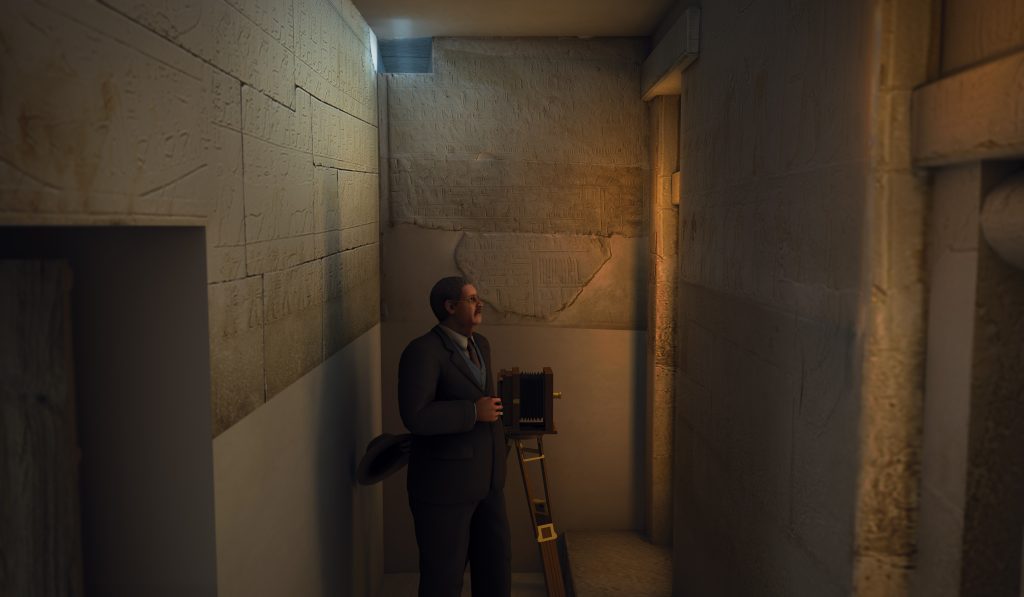
Avatar of George A. Reisner (1867–1942), Harvard’s first Professor of Egyptology, standing in a Giza tomb chapel. Still image from 3D animation. Image courtesy of Dassault Systèmes, Paris.
But what is an accurate digital representation for a tomb that is more than four thousand years old? Hopkins and Gant note that where a damaged column of hieroglyphs appears on the tomb chapel wall of Queen Meresankh, colleagues Aronin and Picardo could theoretically reconstruct the missing signs based on Egyptological research. What, then, should be the conventions for displaying reconstructions of hieroglyphs? Manuelian dreams out loud, raising the possibility of introducing a timeline mode that would allow users to scroll from four thousand years ago to the present and back again, displaying the site in its original and current states, with many phases in between. Moreover, Manuelian raises the possibility of “crowdsourcing” selected monuments so that Egyptologists and digital artists from around the globe could get involved in populating the site with additional data at a faster pace. Gant notes that crowdsourcing was unimaginable ten years ago when the Giza work began. Today, powerful bandwidth and widespread access to the same digital tools and formats have leveled the playing field among research centers around the globe.

Digital reconstruction of the subterranean tomb chapel of Queen Meresankh (G 7530-7540), discovered by the Harvard University–Boston Museum of Fine Arts Expedition in 1927. Image courtesy of the Giza Project.
The research possibilities for the Giza 3D model have also increased dramatically. “We have now come to the point where we are no longer just using research in order to build a visual model,” adds Picardo, “but we are also reversing the process, taking the model and using it for research.” This is the “future of digital archaeology,” he contends, noting that it is “a pioneering effort in the field of Egyptology.” Already, images from the reconstructed models of selected Giza tombs grace Manuelian’s scholarly publications, including, most recently, Mastabas of Nucleus Cemetery G 2100. Manuelian and Gant also envision expanding accessibility to an even larger public, making the work available to visitors on the Giza Plateau itself, and in the forthcoming Grand Egyptian Museum, scheduled for completion a few years from now, as well as in museums at Harvard and elsewhere.

A museum visitor experiences the immersive environment of the Giza Plateau. Photo courtesy of the Giza Project.
The Giza Archives and Giza3D visualizations are at an exciting juncture in research, development and dissemination, with possibilities applicable to HarvardX and EdX as well. Aronin smiles as she acknowledges the Sisyphean task at hand; though the current crop of team members may not be able to render the entire repertoire of the Giza Plateau’s temples, tombs and artifacts in 3D, they will nevertheless set the stage for the next generation of scholars to come.
Check it out: http://www.gizapyramids.org http://giza3d.3ds.com
- Utility Menu
Giza 3D: Harvard's Journey to Ancient Egypt

Harvard University brings the Giza Plateau to life. Watch to learn more about their Giza 3D project, the Harvard Semitics Museum, and virtual reality technology of the future.
The Giza Project at Harvard University
- Project Director Peter Der Manuelian
- Location Giza Plateau
- Affiliation Harvard University
- Project Dates 2000-Present
The Giza Project , a non-profit international initiative based at Harvard University, assembles information about all the archaeological activity at the most famous site in the world: the Giza Pyramids and surrounding cemeteries and settlements (third millennium BCE to present). Using digital archaeology, the Project unites diverse documentation to produce powerful online and traditional academic research tools and new teaching technologies. It presents academic information about Giza at all levels of expertise for the world community and strives to provide a model of archaeological information management.

The mission statement above describes a project that began back in 2000 at the Museum of Fine Arts, Boston, with generous support from the Andrew W. Mellon Foundation. Rather than simply scan all 45,000 glass plate expedition negatives from George Reisner’s Harvard University–Boston Museum of Fine Arts Expedition (1905–1947), we decided instead to focus on “just” the 21,000 Giza photos, but link them intelligently with as much additional metadata as possible. Assembling a team of Egyptologists, PhD candidates, undergraduates, volunteers, and talented and dedicated MFA Museum Associates women, we transcribed expedition diaries, created artifact databases from original object register books, scanned maps, plans, sections, and epigraphic drawings of scenes and inscriptions, and converted scholarly publications into a massive Giza digital library of text-searchable pdf files. Everything fit into its appropriate module in our TMS collections management system, now dubbed “GizaCARD,” and the Project’s first website launched in 2005. Each of the hundreds of Giza tombs surrounding the Pyramids became a central “node” in our system, linked to its appropriate photos, diary pages, object records, drawings, publications, etc.
Since focusing only on the parts of the Giza Necropolis excavated by the HU–MFA Expedition precluded any holistic attempt to study the entire site, we next brought on board all the museums and institutions with a direct archaeological connection to Giza. We have added digital data from Berkeley, Berlin, Cairo, Hildesheim, Leipzig, Philadelphia, Turin, and Vienna in an attempt to build “Giza International,” a sort of centralized repository. We also discovered in Egypt some seventy-four Arabic expedition diaries kept safely all these years by the descendants of George Reisner’s Egyptian foremen. Mellon Foundation funding totaled about $3.4 million and supported us from 2000 to 2010.
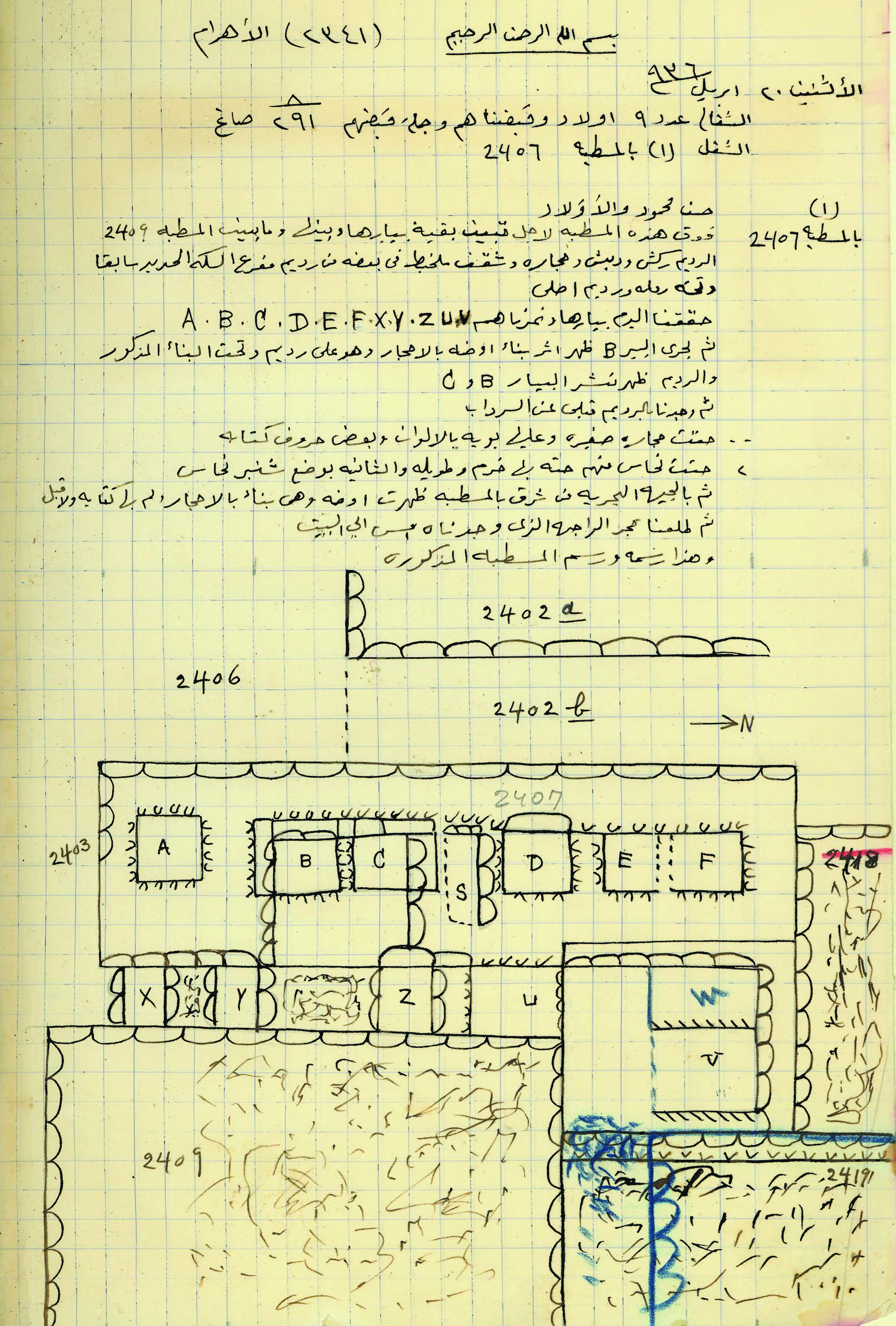
Aiming to take our digital data to the next level, we teamed up with French 3D modeling company Dassault Systèmes (Paris and Waltham, MA) and immersive experience and virtual/augmented reality partner Emissive (Paris) to build 3D models of Giza for teaching and research. Breathing new life into old data came in particularly handy in 2010 when the Giza Project moved to Harvard University. Like George Reisner himself (1867–1942), who was also an MFA curator and Harvard professor, the Giza Project was now able to represent both institutions in a collaborative partnership. The work also fed directly into undergraduate and graduate courses taught in Harvard’s customized Visualization Lab classroom.
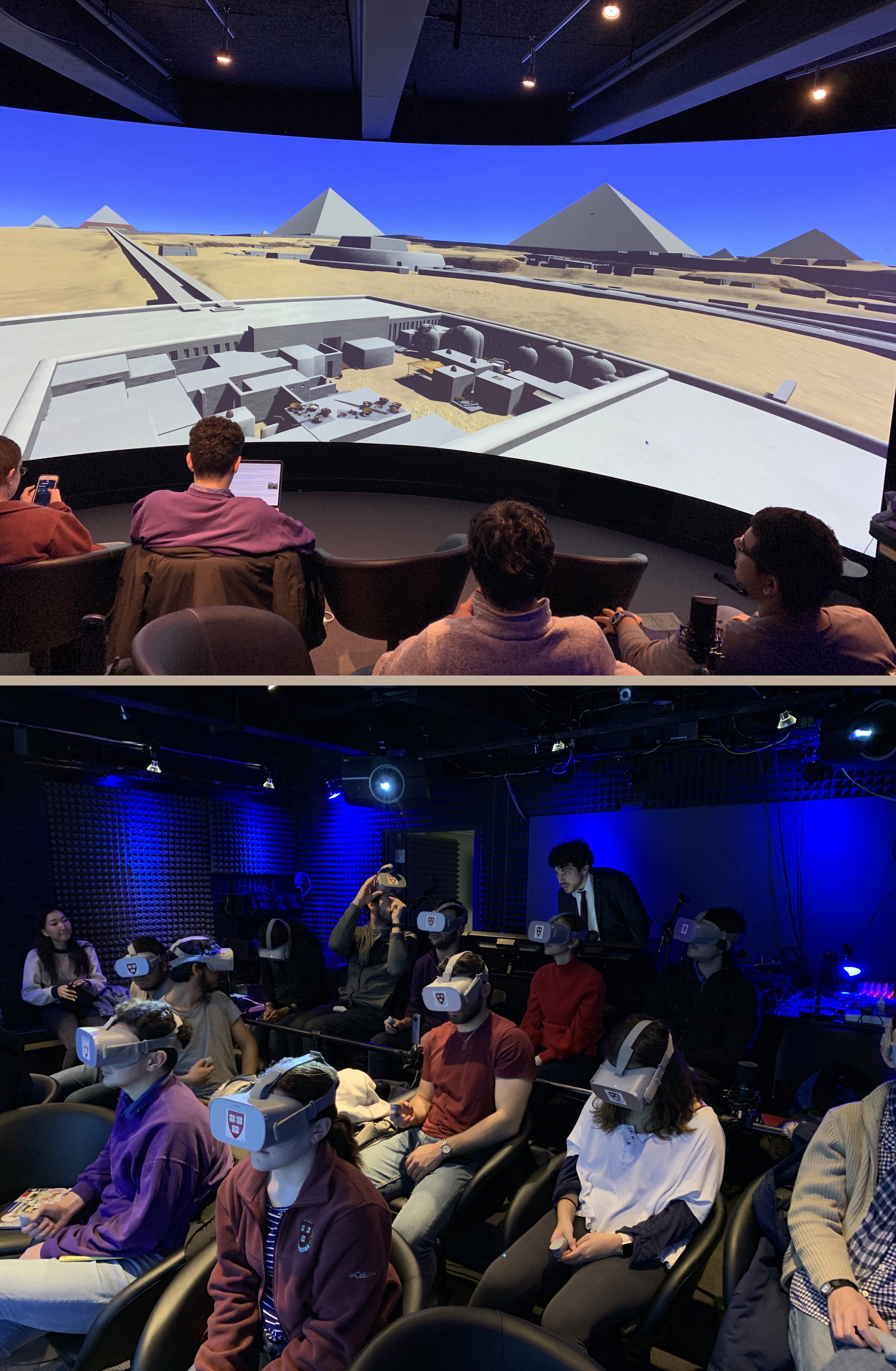
Supported by a series of NEH grants, the Giza Project at Harvard roughly doubled the number of records online over what had been collected at the MFA. We expanded into “educational telepresence,” building out 3D models, not only for our new Harvard-based website, but for immersive stereo headset use as well. The Project’s outreach expanded as well, and a HarvardX online “Giza Pyramids” course (8 modules, 60 videos) has reached a total enrollment at this writing of 116,639 learners from 160 countries. Some of our work overlapped with the mission of the Harvard Museum of the Ancient Near East, such as the free “Dreaming the Sphinx” augmented reality app for the Thutmose IV Sphinx Stela we launched on the Apple App and Google Play stores.

From 2018 onwards, the Giza Project teamed up with Zhejiang University (ZJU) in Hangzhou. Visiting computer scientist Dr. Changyu Diao joined us for a year, contributing to a wide variety of projects, including back-end web coding, live-streaming our Giza classes to China, and 3D scanning and 3D printing, the last item thanks to several PLA printers generously donated by Sindoh.
Now just over twenty years on, with 152,464 items at present in our “GizaCARD” database and on our website, we have recently been enhancing the website (figure 6), with a IIIF-compliant “Mirador” image viewer; the ability to save and share collections (“MyGiza”); and educational features such as “Giza@School,” including an interactive timeline on Giza archaeological history. Through collaboration with ICONEM we hope to combine drone footage with our own interactive tours and a GIS overlay that will allow for enhanced research as well as edu-tourism. New sourcing documents will explain how we built our 3D structures, while photogrammetry and Sketchfab object models and virtual tours of Giza tomb chapels will enable a host of new scholarship opportunities.
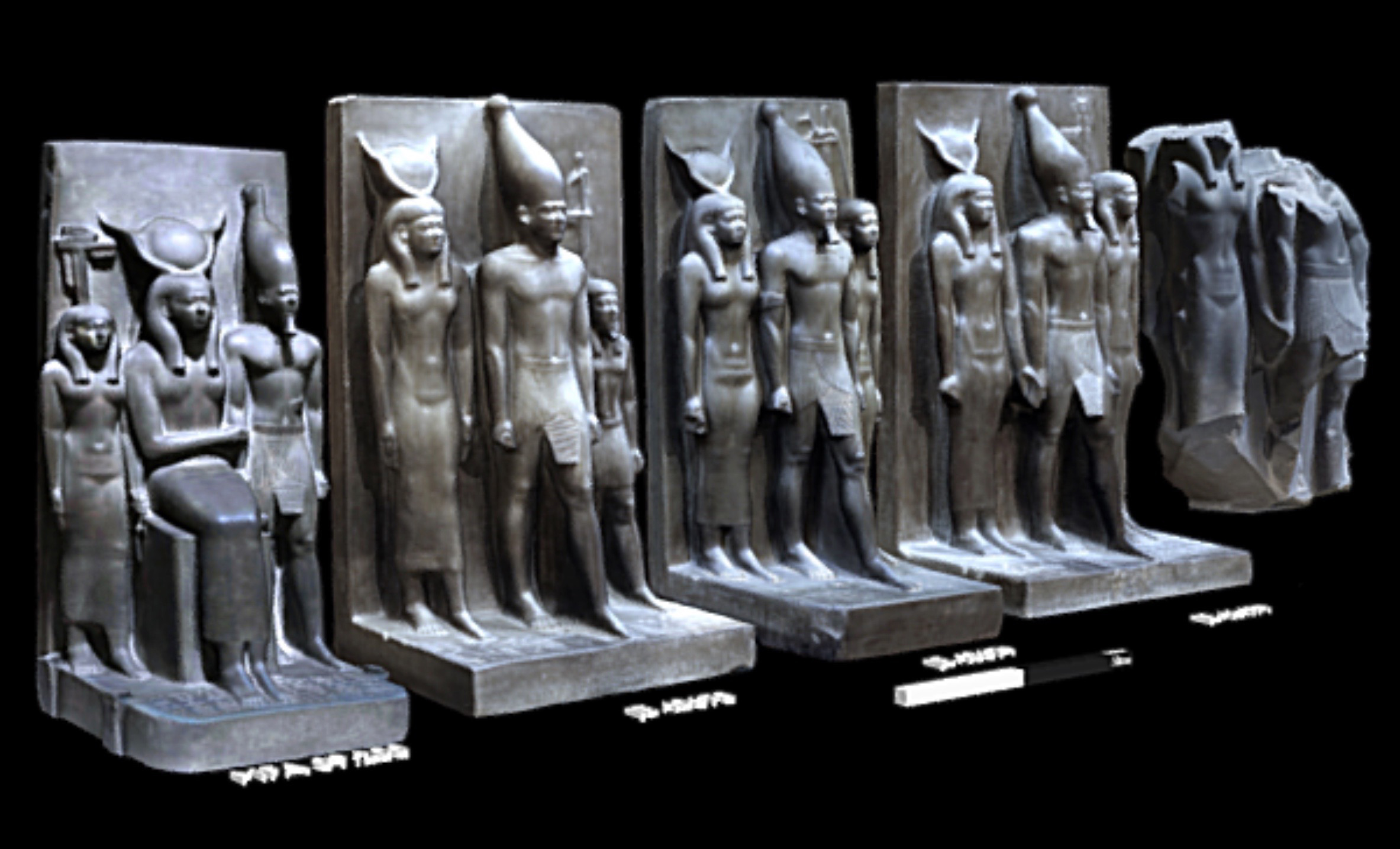
A description of the first decade of the Giza Project was published in 2017 by Harvard University Press . Funding remains an ongoing challenge but with proper support we hope to continue to document the past, present, and future at Giza, one of the world’s most important heritage sites.
- Nicholas Picardo, Project Supervisor and Research Associate
- Luke Hollis, Lead Technical Artist
Project Team Members:
After twenty years, the Giza Project has benefited from the work of almost 1,000 different people. Among those with fundamental contributions are Diane Flores, Catherine Pate, Nicholas Picardo, Rachel Aronin, Jeremy Kisala, Luke Hollis, Rus Gant, David Hopkins, Josh Widdicombe, Changyu Diao, and Harvard Egyptology and archaeology PhD candidates Laura Taronas, Kate Rose, Sara Zaia, Inês Torres, Hilo Sugita, Julia Puglisi, Sergio Alarcón Robledo, Nisha Kumar, and Gaia Bencini. We also thank Rashmi Singhal and Cole Crawford of DARTH, Jeff Steward (HAM), and Henry Perkins and the staff of Harvard’s FAS Research Computing. We also thank volunteers John Thompson, Doug Hall, Erika Kelley, Jenny Cashman, Daniel Leon, and Maarten Praet.
The Giza Project brings together archival holdings from a number of institutions, including:
- The Museum of Fine Arts, Boston (USA)
- The Ägyptisches Museum der Universität Leipzig (Germany)
- The Berlin Ägyptisches Museum (Germany)
- The Egyptian Museum, Cairo (Egypt)
- The Grand Egyptian Museum (Egypt)
- The Kunsthistorisches Museum, Vienna (Austria)
- The Museo Egizio, Turin (Italy)
- The Peabody Museum of Archaeology and Ethnology, Harvard University (USA)
- The Phoebe A. Hearst Museum of Anthropology, University of California, Berkeley (USA)
- The Roemer- und Pelizaeus-Museum, Hildesheim (Germany)
- The University of Pennsylvania Museum of Archaeology and Anthropology, Philadelphia (USA)
- Ancient Egypt Research Associates
The Giza Project gratefully acknowledges current and past support from the following organizations:
- The National Endowment for the Humanities
- Harvard University
- Mr. Sadek Wahba
- Google for Education
- Dassault Systèmes
- Leon Levy Foundation
- The Museum of Fine Arts, Boston
- Andrew W. Mellon Foundation
Renew Your Membership
Keep your ARCE membership by renewing
Support ARCE Today
Donate to support research into egypt's rich history and the preservation of its cultural heritage..

2024 Virtual Annual Meeting
Register Today!
Pyramids of Giza: Ancient Egyptian Art and Archaeology
Learn about ancient egypt’s most famous archaeological site.
Join Harvard Professor Peter Der Manuelian in exploring the archaeology, history, art, and hieroglyphs surrounding the famous Egyptian Pyramids at Giza.

What You'll Learn
Where is Giza? How were the Pyramids built? How did the cemeteries and hundreds of decorated tombs around them develop? What was Giza’s contribution to this first great age of ancient Egyptian civilization, the Old Kingdom?
The Giza Plateau and its cemeteries — including the majestic Pyramids and the Great Sphinx — are stirring examples of ancient Egyptian architecture and culture. They provide windows into ancient Egyptian society, but also contain mysteries waiting to be solved. The Egyptian Pyramids at Giza provide an opportunity to explore the history of archaeology and to learn about some of the modern methods shaping the discipline today.
This introductory course will explore the art, archaeology, and history surrounding the Giza Pyramids. We will learn about Egyptian pharaohs and high officials of the Pyramid Age, follow in the footsteps of the great 20th-century expeditions, and discover how cutting-edge digital tools like 3D-modeling are reshaping the discipline of Egyptology.
Join us on this online journey to ancient Egypt’s most famous archaeological site as we uncover the history and significance of Giza, and use new digital techniques to unravel the mysteries of its ancient tombs and temples.
The course will be delivered via edX and connect learners around the world. By the end of the course, participants will understand:
- The history and significance of the Giza Pyramids and surrounding cemeteries
- Who explored the Pyramids and how they documented their discoveries
- The cultural and religious significance of the Giza Pyramids, tombs, and temples
- The role of hieroglyphic inscriptions in the tombs at Giza
- An appreciation for Egyptian art of the Old Kingdom, or Pyramid Age
- How digital technologies allow us to visualize ancient monuments in new ways
- What the future holds for our understanding and experience of Giza
Your Instructor
Peter Der Manuelian received his Ph.D. in Egyptology from the University of Chicago in 1990. In 2009, he was appointed the “Philip J. King Professor of Egyptology” at Harvard University (Department of Near Eastern Languages and Civilizations, and Department of Anthropology). This is the first Egyptology chair at Harvard since the time of George Reisner (1867-1942), more than 75 years ago. He is director of the Harvard Semitic Museum, and also directs the Giza Project at Harvard, and the MA Program in Museum Studies at the Harvard Extension School. He joined the curatorial staff at the Museum of Fine Arts, Boston, in 1987, and was Giza Archives Project Director there from 2000–2011, in addition to teaching at Tufts University for ten years. His primary research interests include ancient Egyptian history, archaeology, digital epigraphy and visualization, the development of mortuary architecture, and the (icono)graphic nature of Egyptian language and culture in general.
Ways to take this course
When you enroll in this course, you will have the option of pursuing a Verified Certificate or Auditing the Course.
A Verified Certificate costs $219 and provides unlimited access to full course materials, activities, tests, and forums. At the end of the course, learners who earn a passing grade can receive a certificate.
Alternatively, learners can Audit the course for free and have access to select course material, activities, tests, and forums. Please note that this track does not offer a certificate for learners who earn a passing grade.
Related Courses
Masterpieces of world literature.
Join Harvard faculty, David Damrosch and Martin Puchner, in this online course to embark on a global journey to explore the past, present, and future of world literature.
Leaders of Learning
Explore and understand your own theories of learning and leadership. Gain the tools to imagine and build the future of learning.
Religious Literacy: Traditions and Scriptures
Led by Harvard faculty, this course will help you learn to better understand the complex ways that religions function in historic and contemporary contexts.
- Utility Menu
GA4 Tracking Code
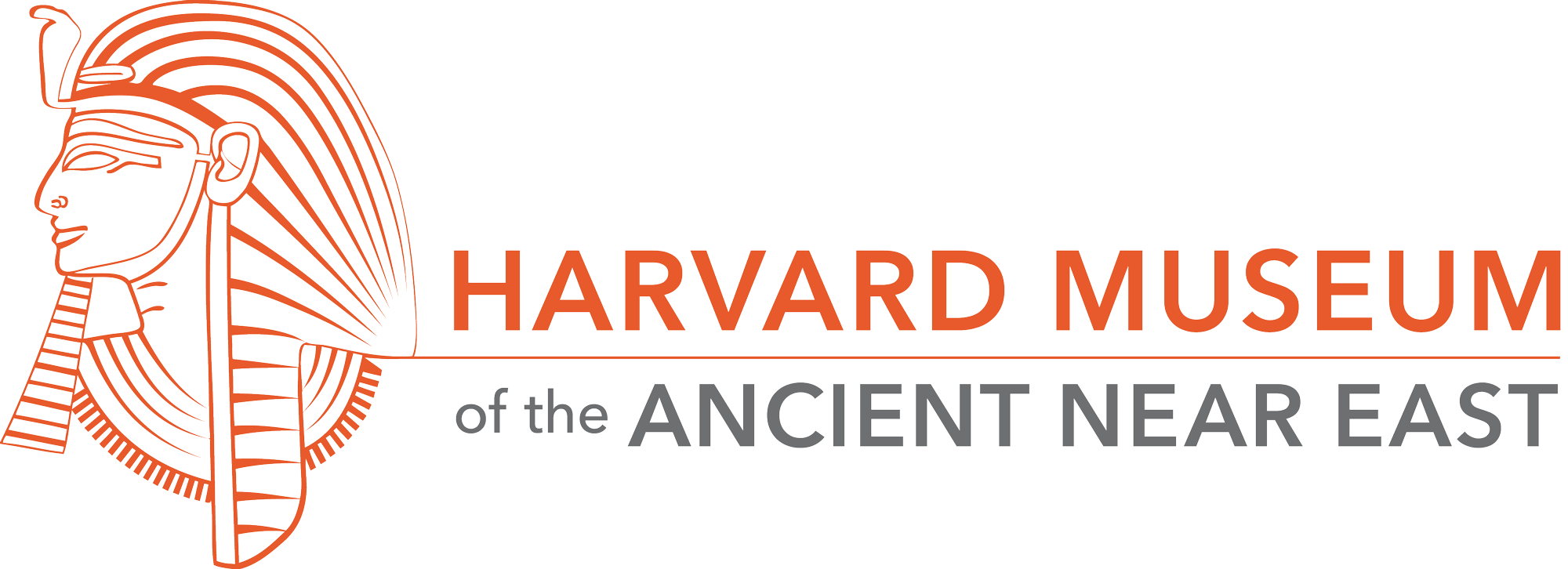
- In the News
- Departments and Centers
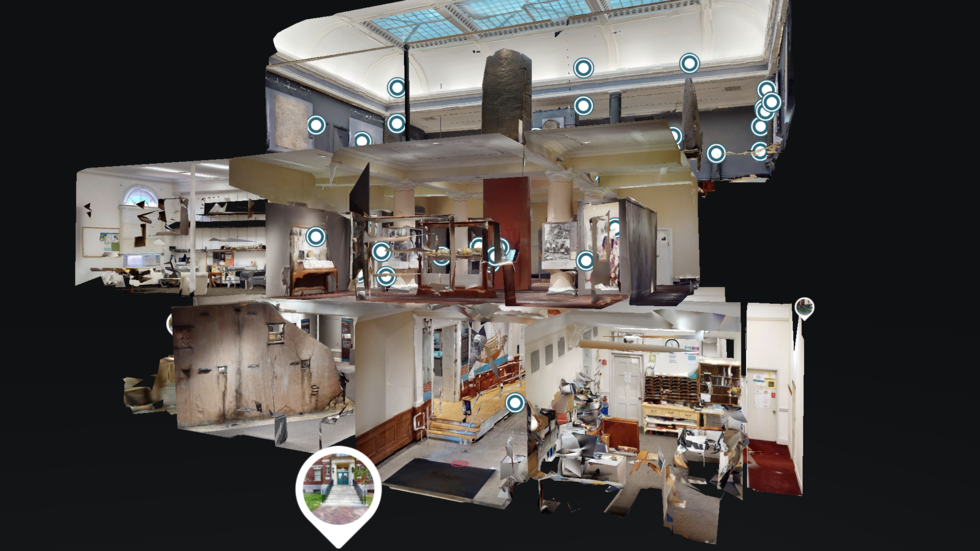

Explore Our Online tour!
Click to view 3d models of coffins of pa-di-mut, mut-iy-y, and ankh-khonsu.
The Harvard Museum of the Ancient Near East is one of the four Harvard Museums of Science & Culture.
Admission: Free
Closed the following days :
- Wednesday, November 27, 2024 (day before Thanksgiving)
- Thursday, November 28, 2024 (Thanksgiving Day)
- Saturday, December 21, 2024
- Sunday, December 22, 2024
- Monday, December 23, 2024
- Tuesday, December 24, 2024 (Christmas Eve)
- Wednesday, December 25, 2024 (Christmas)
- Wednesday, January 1, 2025 (New Year's Day)
Museum closes early on the following days:
- Tuesday, February 27, 2024 (Third floor closure at 3:00 pm)
- Thursday, March 7, 2024 (at 3:00 pm)
- Tuesday March 26 (at 3:30 pm)
- Tuesday, May 7, 2024 (at 3:00 pm)
New Immersive Augmented Reality Snapchat Filter
Art of intimidation promo.
Director's Welcome
Semitic museum promotional piece (short).
How to use the Virtual Tour
How to take a virtual tour at the harvard museum of the ancient near east.
Recent Publications
- Tel Miqne-Ekron Excavations 1994–1996, Field IV Upper and Field V: The Elite Zone, Part 1: Iron Age IIC Temple Complex 650
- Tel Miqne-Ekron Excavations 1994–1996, Field IV Upper and Field V, The Elite Zone Part 2: Iron Age IIC Temple Complex 650 Sections, Plans and Database
- Ashkelon 9: The Hellenistic Period
Peg Figurine by Harvard Museum of the Ancient Near East on Sketchfab
The museum has created 3D models of some choice objects from its collections. This peg-shaped, stone figurine would have been placed in the foundation of an important structure as it was being built. You can view more of our models here .
Advertisement
Harvard, MFA Unveil Virtual 3D Tour Of Ancient Egyptian Pyramids
Copy the code below to embed the wbur audio player on your site.
<iframe width="100%" height="124" scrolling="no" frameborder="no" src="https://player.wbur.org/news/2012/05/07/virtual-tour-egypt"></iframe>
- Lynn Jolicoeur
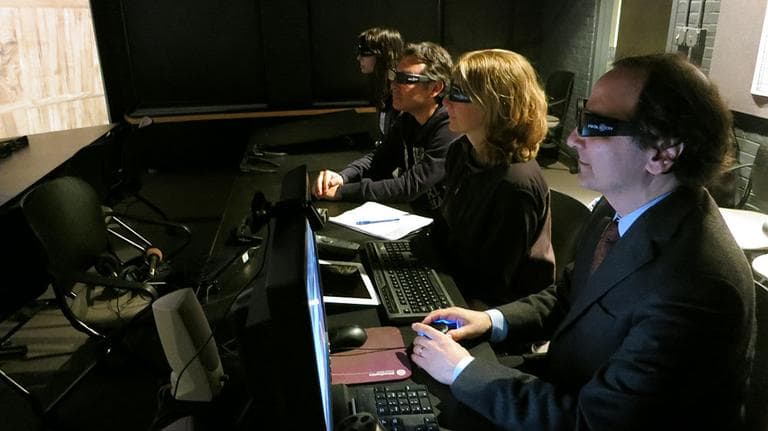
3D has become all the rage in movies and computer games, but the technology isn't just for entertainment. Researchers at Harvard University and the Museum of Fine Arts are turning it into a learning tool, too. Beginning Tuesday, they're offering you a free 3D virtual tour of the ancient pyramids of Egypt.
"I don't play video games," Peter Der Manuelian said with a laugh. "This is as close as I'll ever come, but it's great fun."
Manuelian is one of the brains behind this project, called Giza 3D. He's been fascinated by ancient Egypt ever since fourth-grade history, and he eventually turned that childhood fascination into a profession: he's Harvard's full-time Egyptologist. In a classroom with a curved floor-to-ceiling screen, he gave me some fancy battery-operated 3-D glasses.
"So put the glasses on, and then push the button," he instructed, "and if the image gets a little darker, you'll know that things are working."
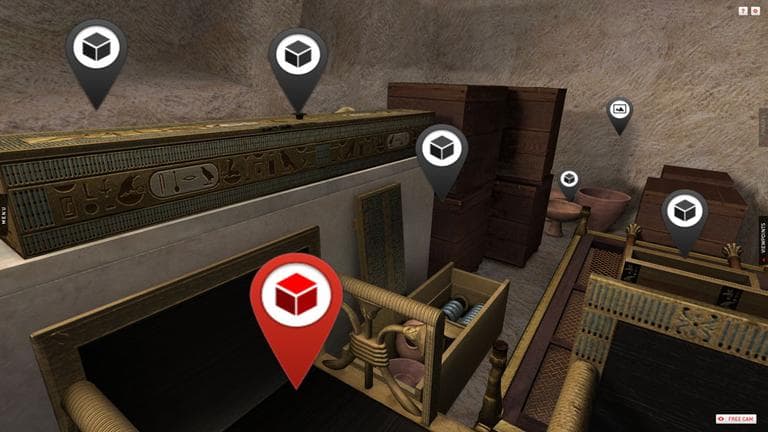
And with that, I get a taste of what anyone with an Internet connection and 3D TV will soon be able to experience.
"So what we're seeing, then, is the Great Pyramid and its temples and long causeway, and the sun is going down to the west," Manuelian said.
It's an animated computer rendering of the Giza Plateau, home to the famous pyramids near modern-day Cairo. Manuelian leads our tour with a device that's a cross between a joystick and a mouse.
"I can steer anywhere I want to go," he explained. "So it's not a linear movie or a frozen video, where I start at the beginning and go to the end. We can dive down a burial shaft, we can visit the pyramid."
We start by flying over the whole complex, getting a bird's-eye view. Then we swoop down into a courtyard to see an ancient Egyptian burial ceremony. Suddenly, with a flick of the joystick, we plunge into a long shaft that leads to a burial chamber.
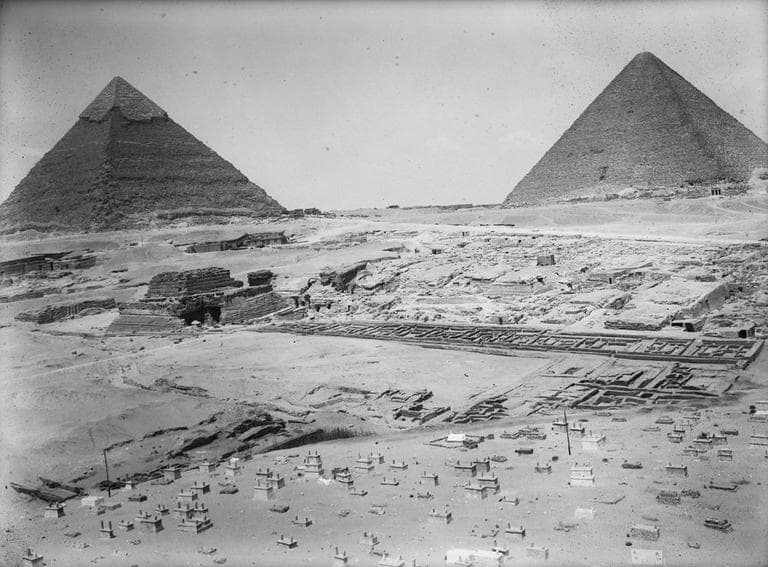
"And I'm going to drive with my mouse and I'll try not to crash into the walls," Manuelian pledged. "And I'll take you down, all the way to the bottom. I hope no one feels seasick!"
It is a little dizzying, and it's all very whiz-bang. But Harvard and the MFA insist this has an educational purpose, too: it's linked to the Giza Archive Project, a massive digital database of materials gathered during a decades-long joint Harvard-MFA expedition of the Giza Plateau. So you can click on anything you come across — say, a tomb — and immediately access all that digitized information.
"Lists of statues, ceramics, objects of daily life from that tomb, references to scholarly publications, maps and plans, old photographs, even unpublished manuscripts," Manuelian reeled off.
This kind of "edu-tourism" has the potential to bring ancient Egypt to the masses, he said. A French software company with U.S. headquarters in Waltham, Dassault Systemes, is behind this technology. One of its vice presidents, Mehdi Tayoubi, called the Giza 3D project the "democratization" of a high-tech tool.
"When a student is here, it's like he's in Giza traveling with Peter as a guide," Tayoubi said. "But back at home, he's able to connect online and to do the travel by himself and to look at some details not raised by Peter during his course," Tayoubi said.
And when Giza 3D goes public Tuesday, you might be able to pay a virtual visit to ancient Egypt, too.
The site will go live early Tuesday morning.
This program aired on May 7, 2012.
More from WBUR
Giza @ School
- You are not logged in.
- Create a MyGiza account
- Browse Collections
- Introduction to Giza
- What is the Giza Project?
- Archaeology at Giza
Welcome teachers and students! Below you'll find resources to help you explore the many facets of ancient Egypt and Giza.
Lesson Topics
Browse artifacts from the Giza archive that relate to popular themes for the classroom — such as Daily Life in Ancient Egypt and What are the Pyramids? — to use in your lesson plans.
People and Places of Giza
Start here for an overview of the Giza Plateau and its most popular topics, like the Great Pyramid , the Sphinx , and King Khufu .
Glossary and FAQ
Studying ancient Egypt, you might come across words and ideas that you don’t see every day. Check here if you’ve got questions!
Video Library
Climb into a pyramid, descend into a tomb, and more in Digital Giza's video experiences.
These resources are just the beginning. For more, search the Digital Giza archive:
See the Giza Plateau in a whole new way:
- Interactive Videos
- Giza 3D Models
More Resources
Explore further with some of The Giza Project's favorite places online.
Clicking these links will open a new browser tab.
EDSITEment!
Lesson plans and study activities from the National Endowment for the Humanities (NEH). Check out their modules on Ancient Egypt's pyramids and scroll paintings .
Voices of Ancient Egypt
Features a YouTube video channel as well as articles on popular topics such as hieroglyphs.
NileScribes
Weekly posts on the latest in Egyptology, in both English and Arabic.
Ancient Egypt Research Associates (AERA)
Professional group with a mission to advance archaeological research, conservation, and training in Egypt.
Egyptology Resources
Long-standing online resource for those interested in Egyptology, professionals or not. Hosted by the Fitzwilliam Museum.
Name of this image
Description of the image duis mollis, est non commodo luctus, nisi erat porttitor ligula, eget lacinia odio sem nec elit. Sed posuere consectetur est at lobortis. Donec sed odio dui.
- Heather ONeill [email protected] ×
- Nicholas Picardo [email protected] ×
- Luke Hollis [email protected] ×
- Cole Test Collection - Tomb Chapels and Shafts
- GPH Test Collection 1
- Tombs & Monuments
- Sphinx Complex
- 01-Present location
- Architectural element
- 02-Category
- 05-Material
- 06-Technique
- 07-State of preservation
- 08-Description
- Selected (2)
Questions, comments, concerns? We'd love to hear from you.
All fields below are required. Please note: although we make every effort to respond, we are unable to personally reply to every comment.
Visit the Pyramids of Giza Without Even Leaving Your Couch
By ellen gutoskey | apr 15, 2021.
If going to the Giza Plateau in person is the ultimate way to experience the ancient Pyramids of Giza, Harvard University’s Digital Giza is at least the next best thing.
As Nerdist reports , Digital Giza is an offshoot of Harvard’s Giza Project , an international endeavor to catalog and consolidate archives and information about the Giza Plateau from all over the world. Researchers have used this data to create a digital platform with 3D models, virtual walking tours, and other free interactive resources to help people explore the region from afar.
You can, for example, amble around the largest of the three pyramids, commissioned by King Khufu around 2550 BCE and also known as the Great Pyramid . Not only is it the oldest of the Seven Wonders of the Ancient World, it’s also the only one that still exists (That said, historians aren’t sure that some of them ever existed at all—hard evidence of the Hanging Gardens of Babylon and the Colossus of Rhodes, for example, has proven difficult to find.) The other two pyramids that tower over the rest of the plateau are the Pyramid of Khafre and the Pyramid of Menkaure, built by (and named for) Khufu’s son and grandson, respectively.
Digital Giza offers plenty of sites to explore beyond those three edifices. The Great Sphinx , thought to have been built during Khafre’s reign, is also a must-see. While it’s currently the same sandy color as the rest of the plateau, pigment residue suggests that it might’ve once been painted red, blue, yellow, and perhaps other vibrant hues. The platform also has virtual tours of several extravagant tombs, complete with details about the art and sculptures you see inside.
If you’re interested in an immersive (and educational) virtual vacation, you can explore Digital Giza here .
[h/t Nerdist ]
This Five-Thousand-Year-Old Egyptian Tomb Has Opened for a Virtual Tour

The Pyramids of Giza, Egypt.
The lockdown comes with its own benefits — for one, it lets you travel to far and distant lands from your couch and with a single click of a button. This week the Egyptian Tourist Board opened its doors to the 5,000-year-old tomb of Queen Meresankh III. The tour is one of four virtual trips of historic Egyptian sites being promoted during the lockdown. As part of Harvard University’s Digital Giza Project , the virtual tours, equipped with 3D modeling lend a fascinating deep-dive into the antiquity of the Egyptian pyramids. “An international collaboration based at Harvard University, the project aims to assemble and provide access to all archaeological records about the most famous site in the world: the Pyramids, surrounding cemeteries, and settlements of Giza,” the site explains. To date, the group has modeled approximately 20 tombs and monuments in detail, with many hundreds more still to be done.

Digital Giza seeks to integrate this virtual environment with more than a hundred years of scholarly research about Giza, using cutting edge technology to study the distant past and preserve knowledge about this important cultural heritage site for the future. The free online virtual tours take us right back in time, with the complex 3D modeling giving us a glimpse of the ancient Egyptian world from thousands of years ago. The free tours are a bargain considering they are not only informational but are also downright fascinating and conveniently accessed from the comfort of our couch.

For those interested in 0ther tours, visit the Coptic Red Monastery in Upper Egypt, for its frescoes and the Ben Erza synagogue – founded, as the story goes, on the site where Moses was discovered.
Read Next: You Can Now Take an Online Tour of the Louvre Abu Dhabi for Free
Vogue Recommends
Vogue reviews: five zurich.

Top 10 Saturday Brunches To Try In Dubai For An Unforgettable Weekend

Deema Al Asadi Explores the Exquisite World of St. Regis

Pictures: Inside Vogue Arabia x St. Regis Dubai, The Palm’s Magical Midnight Supper
Suggestions, vogue collection, vogue edition.
Arabia Chevron
Australia Chevron
Brasil Chevron
China Chevron
Czechoslovakia Chevron
España Chevron
Germany Chevron
Greece Chevron
Hong Kong Chevron
India Chevron
Italia Chevron
Japan Chevron
Korea Chevron
México Chevron
Nederland Chevron
Paris Chevron
Polska Chevron
Portugal Chevron
Russia Chevron
Singapore Chevron
Taiwan Chevron
Thailand Chevron
Türkiye Chevron
Ukraine Chevron
© 2024 Nervora Fashion, Inc. and Condé Nast. All rights reserved. The material on this site may not be reproduced, distributed, transmitted, cached, or otherwise used, except with the prior written permission of Nervora Fashion, Inc. and Condé Nast.
Awesome, you're subscribed!
Thanks for subscribing! Look out for your first newsletter in your inbox soon!
The best things in life are free.
Sign up for our email to enjoy your city without spending a thing (as well as some options when you’re feeling flush).
Déjà vu! We already have this email. Try another?
By entering your email address you agree to our Terms of Use and Privacy Policy and consent to receive emails from Time Out about news, events, offers and partner promotions.
- Things to Do
- Food & Drink
- Arts & Culture
- Time Out Market
- Coca-Cola Foodmarks
- Los Angeles
Get us in your inbox
🙌 Awesome, you're subscribed!

Discover the secrets of Egypt’s Great Pyramid on this new virtual tour
A new tool gives you access to the inside chambers of one of the Ancient Wonders of the World

Always wanted have a look around an Egyptian pyramid but never quite managed to go all the way to Giza? Here’s your chance for a sneak peek. You can now take a free virtual tour of the Great Pyramid of Giza – and, even online, it’s pretty spectacular.
On a website called Giza.Mused , the tour gives viewers a comprehensive look into one of Egypt’s most famous pyramids. It renders the ‘entire interior’ in digital 3-D form, taking virtual tour attendees through the king’s chamber at the top, the queen’s chamber in the middle and a subterranean chamber, which is cut into the bedrock beneath.
So what’s so special about the Great Pyramid of Giza – despite, obviously, it being ‘great’ and all? Well, it’s the biggest pyramid in Egypt and stands at just over 138 metres tall. Built about 4,600 years ago, it houses the tomb of fourth dynasty pharaoh Khufu and is one of the Seven Wonders of the Ancient World (and the only Ancient Wonder still standing).
In other words, it’s a pretty sweet place to get a virtual tour of. Giza.Mused doubles up as a fascinating history lesson, with facts about everything from its construction and location to the current entrance, which was apparently dug by robbers in the ninth century.
You can do the tour for yourself here – and get fantasising about just how incredible it would be to see the pyramids IRL.
Stay in the loop: sign up to our free Time Out Travel newsletter for the latest travel news and the best stuff happening across the world.
- Ed Cunningham News Editor, Time Out UK and Time Out London
Share the story
An email you’ll actually love
Discover Time Out original video
- Press office
- Investor relations
- Work for Time Out
- Editorial guidelines
- Privacy notice
- Do not sell my information
- Cookie policy
- Accessibility statement
- Terms of use
- Modern slavery statement
- Manage cookies
- Advertising
Time Out Worldwide
- All Time Out Locations
- North America
- South America
- South Pacific

American School
National school.

IMAGES
VIDEO
COMMENTS
Explore the models and tours; you will find links to other models throughout. Or choose from individual tours below. ... Virtual Tours. The Mastaba Tomb of Queen Mersankh III (G 7530-7540) The Mastaba Tomb of Khufukhaf (G 7130-7140) ... Nicholas Picardo [email protected] ...
The Giza Project, an international collaboration based at Harvard University, aims to assemble and provide access to all archeological records about the most famous site in the world: the Pyramids, surrounding cemeteries and settlements of Giza, Egypt.
Students wearing 3D glasses take a virtual tour of ancient Egypt in Peter Der Manuelian's "Pyramid Schemes" class. Photos by Stephanie Mitchell/Harvard Staff Photographer. Alvin Powell Harvard Staff Writer ... studying a tomb that has one room in Boston and the rest in Egypt, a virtual model is the only way to see the intact structure, so ...
360° Virtual Reality Tour of Egypt and the Nile. ... the site to see 360° videos of sailing on the Nile, Karnak Temple, Luxor, and more! The Giza Project. The Giza Project at Harvard University gives you access to the largest collection of information, media, and research materials ever assembled about the Pyramids and related sites on Egypt ...
April 17, 2020. A virtual view of the Red Monastery, one of five Egyptian heritage sites newly detailed in 3-D Egypt's Ministry of Tourism and Antiquities. Earlier this month, Egypt's Ministry ...
The Giza Project is a non-profit international initiative based at Harvard University. Through digital archaeology, we assemble, curate, and present archaeological records about one of the most famous archaeological sites in the world, the Giza Pyramids and surrounding cemeteries and settlements. The Project manages arguably the world's ...
The research possibilities for the Giza 3D model have also increased dramatically. "We have now come to the point where we are no longer just using research in order to build a visual model," adds Picardo, "but we are also reversing the process, taking the model and using it for research.". This is the "future of digital archaeology ...
Take the Digital Giza Project at Harvard University, for example. From the comfort of our living rooms, we can read about the Great Pyramids of Giza—and even go on 3D tours. The project, which ...
Giza 3D: Harvard's Journey to Ancient Egypt. October 14, 2016. Harvard University brings the Giza Plateau to life. Watch to learn more about their Giza 3D project, the Harvard Semitics Museum, and virtual reality technology of the future. Peter Der Manuelian. Barbara Bell Professor of Egyptology. Director, Harvard Museum of the Ancient Near East.
Project Dates 2000-Present. The Giza Project, a non-profit international initiative based at Harvard University, assembles information about all the archaeological activity at the most famous site in the world: the Giza Pyramids and surrounding cemeteries and settlements (third millennium BCE to present). Using digital archaeology, the Project ...
This introductory course will explore the art, archaeology, and history surrounding the Giza Pyramids. We will learn about Egyptian pharaohs and high officials of the Pyramid Age, follow in the footsteps of the great 20th-century expeditions, and discover how cutting-edge digital tools like 3D-modeling are reshaping the discipline of Egyptology.
The Harvard Museum of the Ancient Near East is one of the four Harvard Museums of Science & Culture. Admission: Free. Hours: Sunday-Friday, 11:00am-4:00pm. Closed the following days: Wednesday, November 27, 2024 (day before Thanksgiving) Thursday, November 28, 2024 (Thanksgiving Day) Saturday, December 21, 2024. Sunday, December 22, 2024.
Researchers at Harvard University and the Museum of Fine Arts are turning it into a learning tool, too. Beginning Tuesday, they're offering you a free 3D virtual tour of the ancient pyramids of ...
Take a walking tour of the Giza Pyramids with Harvard Professor Peter Der Manuelian.From our online course, "Pyramids of Giza: Ancient Egyptian Art and Archa...
Climb into a pyramid, descend into a tomb, and more in Digital Giza's video experiences. These resources are just the beginning. For more, search the Digital Giza archive:
Thanks to the Digital Giza Project from Harvard University, you can take a virtual tour through ancient Egyptian pyramids and tombs from the comfort of your home. The Giza Project provides couch-surfing tourists with the tools and information gathered by academics, to learn all about one of the world's oldest attractions. Started by the ...
Researchers have used this data to create a digital platform with 3D models, virtual walking tours, and other free interactive resources to help people explore the region from afar. You can, for ...
The tour is one of four virtual trips of historic Egyptian sites being promoted during the lockdown. As part of Harvard University's Digital Giza Project, the virtual tours, equipped with 3D modeling lend a fascinating deep-dive into the antiquity of the Egyptian pyramids. "An international collaboration based at Harvard University, the ...
Here's your chance for a sneak peek. You can now take a free virtual tour of the Great Pyramid of Giza - and, even online, it's pretty spectacular. On a website called Giza.Mused, the tour ...
TAKE A VIRTUAL TOUR OF THE SCHOOL TAKE TOUR. American School. Join Now. National School. Join Now
Thanks to the Digital Giza Project from Harvard University, you can take a virtual tour through ancient Egyptian pyramids and tombs from the comfort of your home. The Giza Project provides couch-surfing tourists with the tools and information gathered by academics, to learn all about one of the world's oldest attractions. Started by the ...